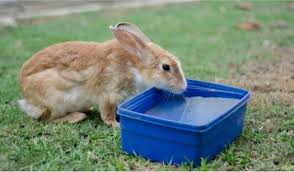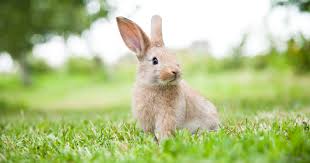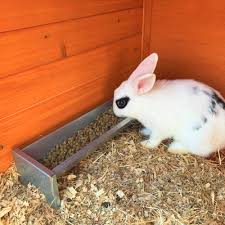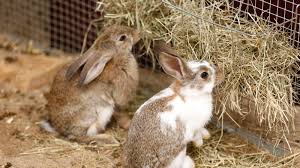The domestic rabbit will eat most types of green vegetables, grains, tubers, and roots. Therefore, the ration may consist almost entirely of ingredients from plant sources.
A. Nutrient Requirements of Rabbits
Kitchen wastes, such as uncooked vegetables, cereals, and remains of meals, can be fed to rabbits provided certain rules are followed:
- The waste must be fed when fresh and unsoured.
- It must be removed after a few hours if it is not eaten.
- It should represent less than half of the rabbit’s daily ration.
Read Also: Amazon Flowers: All You Need To Know About
1. Water Requirements for Rabbits

Water should be supplied ad libitum. Rabbits have high water requirements in relation to their body size. Water is essential for maintenance, production, and lactation since dry matter intake is related to water intake.
Any restriction in water intake causes a decline in dry matter consumption. However, if feeding is restricted, water intake may increase. Water should be clear, fresh, and free from biological and chemical contaminants.
2. Protein Requirements for Rabbits
The quality and quantity of protein are not as critical for rabbits as they are for poultry. Rabbits can adapt to poor and low-protein situations, but production will not be optimal. With high-quality protein, optimum production can be achieved.
Crude protein is an approximate measure of the total amount of amino acids. For rabbits, the recommended crude protein level in the dry matter of the ration is:
- Over 18% for newly weaned rabbits.
- 16-18% for rabbits from 12 to 24 weeks.
- 15-17% for a breeding doe.
- 12-14% for all other stocks.
3. Energy Requirements of Rabbits
The energy requirement of rabbits is derived from the fibrous components of their feed. Energy requirements range between 2390 and 2500 kcal of digestible energy. This energy can be supplied from fats, grains like maize, cereal bran, and fibrous feeds.
4. Fat Requirements for Rabbits

Rabbits can tolerate up to 20-25% fat in the diet, depending on their age. Fat provides energy as well as supplying essential fatty acids. It also improves feed palatability and reduces dustiness in the feed.
5. Carbohydrate Requirements for Rabbits
Grains are the readily available carbohydrates in rabbit feed.
6. Fibre Requirements for Rabbits
Rabbits eliminate fibre and digest the non-fibrous components of the feed. The anti-peristalsis wave on the proximal colon, in conjunction with normal contractions in the caecum, are responsible for the separation and excretion of fibre. The digestion of cellulose is low.
7. Mineral Requirements for Rabbits
Calcium is essential for bone formation and is involved in blood clotting, controlling the excitability of nerves and muscles, and maintaining acid-base equilibrium. Phosphorus is a component of cellular constituents such as adenosine triphosphate (ATP), deoxyribonucleic acid (DNA), ribonucleic acid (RNA), and phospholipids.
Phosphorus is also a component of bone. Calcium absorption is influenced by its level in the feed. Dietary phosphorus and vitamin D factors have not been critically studied in rabbits.
The calcium level in the serum of rabbits is higher than in other species, as other species maintain a regulated constant level of calcium through a process called homeostasis. Since this homeostasis is absent in rabbits, dietary calcium levels directly affect the blood in an unregulated manner.
Read Also: Pumpkin Flowers (Pumpkin Blossoms): Complete Growing and Care Guide
8. Vitamin Requirements for Rabbits

Vitamins are chemicals required in very small amounts to speed up chemical reactions within the rabbit’s body. The most important vitamins for rabbits are vitamins A and D, and the B vitamins, including choline and thiamine.
B. Caecotrophy in Rabbits
Caecotrophy, sometimes referred to as refection, is the eating of faecal-like pellets produced in the caecum. Rabbits produce two types of faeces:
- Hard faeces
- Soft faeces or caecotropes.
Rabbits have a specialized mechanism that retains ingestion in the proximal colon and caecum for microbial utilization of nutrients and allows the formation of these two types of faeces. The faeces suitable for consumption are the soft faeces, which originate from the caecum (cecotropes), while the hard faeces are not eaten by the rabbit.
C. Feeding Systems for Rabbits

Rabbits kept in hutches or colonies are entirely dependent on their keeper for food, unlike wild rabbits, which select their own food based on instinct. The rabbit keeper lacks this instinct and must, therefore, carefully consider the best food for the rabbits.
It is clear that rabbit nutrition is the most important aspect of their production, as inadequate nutrition will weaken the rabbit’s ability to resist disease and environmental stress.
In this article, we have studied that domestic rabbits consume various types of green vegetables, grains, tubers, and roots. Kitchen wastes such as uncooked vegetables, cereals, and meal remains can be fed to rabbits, following specific rules: water should be supplied ad libitum.
The recommended crude protein level in the dry matter of the ration is over 18% for newly weaned rabbits, 16-18% for rabbits from 12 to 24 weeks, 15-17% for breeding does, and 12-14% for all other stocks.
The energy requirement ranges from 2390 to 2500 kcal of digestive energy. Rabbits can tolerate up to 20-25% fat in their diet depending on their age. The digestion of cellulose is low, and caecotrophy is the consumption of faecal-like pellets produced in the caecum. There are three possible feeding systems for rabbits:
- Extensive system, which relies entirely on forages and kitchen wastes.
- Intensive system, which depends entirely on prepared concentrate feeds from the feed mill.
- Semi-intensive system, which uses forages supplemented with prepared concentrate feeds.
Do you have any questions, suggestions, or contributions? If so, please feel free to use the comment box below to share your thoughts. We also encourage you to kindly share this information with others who might benefit from it. Since we can’t reach everyone at once, we truly appreciate your help in spreading the word. Thank you so much for your support and for sharing!

